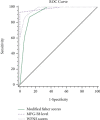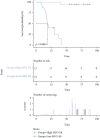DCI after Aneurysmal Subarachnoid Hemorrhage Is Related to the Expression of MFG-E8
- PMID: 35005020
- PMCID: PMC8741362
- DOI: 10.1155/2021/6568477
DCI after Aneurysmal Subarachnoid Hemorrhage Is Related to the Expression of MFG-E8
Abstract
Objective: To explore the predictive value of milk fat globule epidermal growth factor 8 (MFG-E8) in the occurrence of delayed cerebral ischemia (DCI) after an aneurysmal subarachnoid hemorrhage (aSAH).
Methods: We recruited 32 patients with aSAH as the case group and 24 patients with unruptured aneurysms as the control group. Serum MFG-E8 levels were measured by western blot and enzyme-linked immunosorbent assay. We analyzed the relationship between MFG-E8 levels and the risk of DCI.
Results: The levels of serum MFG-E8 in the case group (mean = 11160.9 pg/mL) were significantly higher than those in the control group (mean = 3081.0 pg/mL, p < 0.001). MFG-E8 levels highly correlated with the World Federation of Neurosurgical Societies (WFNS) and modified Fisher scores (r = -0.691 and - 0.767, respectively, p < 0.001). In addition, MFG-E8 levels in patients with DCI (5882.7 ± 3162.4 pg/mL) were notably higher than those in patients without DCI (15818.2 ± 3771.6 pg/mL, p < 0.001). A receiver operating characteristic curve showed that the occurrence of DCI could effectively be predicted by MFG-E8 (area under the curve = 0.976, 95%CI = 0.850-1.000). Kaplan-Meier survival analysis showed a remarkable decrease in the incidence of DCI in case group individuals with high levels of MFG-E8 (≥11160.9 pg/mL, p < 0.001).
Conclusion: MFG-E8 may be a useful predictive marker for DCI after an aSAH and could be a promising surrogate end point.
Copyright © 2021 Xianjun Chen et al.
Conflict of interest statement
The authors declare that there is no conflict of interest regarding the publication of this article.
Figures






Similar articles
-
Elevated MFG-E8 in CSF in the Early Stage Indicates Rapid Recovery of Mild Aneurysmal SAH Patients.Dis Markers. 2022 Oct 11;2022:6731286. doi: 10.1155/2022/6731286. eCollection 2022. Dis Markers. 2022. PMID: 36267465 Free PMC article.
-
Serum soluble lectin-like oxidized low-density lipoprotein receptor-1 as a biomarker of delayed cerebral ischemia after aneurysmal subarachnoid hemorrhage.Brain Behav. 2020 Feb;10(2):e01517. doi: 10.1002/brb3.1517. Epub 2020 Jan 14. Brain Behav. 2020. PMID: 31943892 Free PMC article.
-
Milk fat globule epidermal growth factor 8 (MFG-E8) on monocytes is a novel biomarker of disease activity in systemic lupus erythematosus.Lupus. 2021 Jan;30(1):61-69. doi: 10.1177/0961203320967761. Epub 2020 Oct 28. Lupus. 2021. PMID: 33115371
-
Early stage neuroglobin level as a predictor of delayed cerebral ischemia in patients with aneurysmal subarachnoid hemorrhage.Brain Behav. 2020 Mar;10(3):e01547. doi: 10.1002/brb3.1547. Epub 2020 Feb 5. Brain Behav. 2020. PMID: 32026621 Free PMC article.
-
Medin, a link between vascular pathology and dementia?J Cereb Blood Flow Metab. 2024 Dec;44(12):1403-1408. doi: 10.1177/0271678X241289772. Epub 2024 Oct 7. J Cereb Blood Flow Metab. 2024. PMID: 39370976 Free PMC article. Review.
Cited by
-
Construction and Verification of a Risk Prediction Model for the Occurrence of Delayed Cerebral Ischemia after Aneurysmal Subarachnoid Hemorrhage Requiring Mechanical Ventilation.Biomed Res Int. 2023 Feb 17;2023:7656069. doi: 10.1155/2023/7656069. eCollection 2023. Biomed Res Int. 2023. PMID: 36845638 Free PMC article. Clinical Trial.
-
Potent CTLs can be induced against tumor cells in an environment of lower levels of systemic MFG-E8.Cancer Sci. 2024 Apr;115(4):1114-1128. doi: 10.1111/cas.16099. Epub 2024 Feb 8. Cancer Sci. 2024. PMID: 38332689 Free PMC article.
-
Elevated Serum NOX2 Levels Contribute to Delayed Cerebral Ischemia and a Poor Prognosis After Aneurysmal Subarachnoid Hemorrhage: A Prospective Cohort Study.Neuropsychiatr Dis Treat. 2023 Apr 29;19:1027-1042. doi: 10.2147/NDT.S407907. eCollection 2023. Neuropsychiatr Dis Treat. 2023. PMID: 37153352 Free PMC article.
-
Efficacy and safety of beinaglutide with continuous subcutaneous infusion in newly diagnosed patients with type 2 diabetes: a randomized, control, open-labeled clinical trial.J Endocrinol Invest. 2025 Jul 28. doi: 10.1007/s40618-025-02665-7. Online ahead of print. J Endocrinol Invest. 2025. PMID: 40719951
References
-
- Hua X., Gray A., Wolstenholme J., et al. Survival, dependency, and health-related quality of life in patients with ruptured intracranial aneurysm: 10-year follow-up of the United Kingdom cohort of the international subarachnoid aneurysm trial. Neurosurgery . 2021;88(2):252–260. doi: 10.1093/neuros/nyaa454. - DOI - PMC - PubMed
MeSH terms
Substances
LinkOut - more resources
Full Text Sources
Miscellaneous

